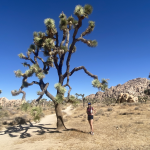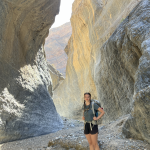By Emma Grace Howlett ‘25
While life at Pomona College can be invigorating, I still look forward to breaks for a chance to explore off campus and recuperate from excessive studying. I spent both fall and spring breaks this year exploring the two national parks within reasonable driving distance of Pomona: Joshua Tree and Death Valley National Park.
 Coming from such a lush, verdant campus I was shocked by the vast, seemingly empty desert of Joshua Tree. While many travelers perceive the California desert as a desolate, monotonous wasteland, a greater attention to detail will reveal how even slight variations of climate and elevation create an amazing diversity of plant life. In fact, Joshua Tree marks the convergence of two different deserts: the Mojave and the Colorado. Joshua Tree is known for… you guessed it, Joshua trees, which are unique to the Mojave Desert. Meanwhile, the Colorado Desert is filled with interesting plants like the ocotillo, which resembles a radiating bouquet of spiny dead sticks. Yet the curious plant life is only part of what makes this park remarkable. Looming, sand-colored rock formations such as Skull Rock uttered a siren’s call to be climbed.
Coming from such a lush, verdant campus I was shocked by the vast, seemingly empty desert of Joshua Tree. While many travelers perceive the California desert as a desolate, monotonous wasteland, a greater attention to detail will reveal how even slight variations of climate and elevation create an amazing diversity of plant life. In fact, Joshua Tree marks the convergence of two different deserts: the Mojave and the Colorado. Joshua Tree is known for… you guessed it, Joshua trees, which are unique to the Mojave Desert. Meanwhile, the Colorado Desert is filled with interesting plants like the ocotillo, which resembles a radiating bouquet of spiny dead sticks. Yet the curious plant life is only part of what makes this park remarkable. Looming, sand-colored rock formations such as Skull Rock uttered a siren’s call to be climbed.
This spring, I went to the hottest place in the world: Death Valley. Luckily the temperatures were hospitable in early March, allowing me to spend five days exploring the park. Never have I seen such a boundless, wide, flat valley. Even more impressive were the 11,000-ft mountains that bordered the valley, the tops of which were dusted with snow. The scale of this place was monumental, making me feel insignificant compared to the primal, earth-shaping forces laid out before me.
 I spent the first two days hiking through Marble Canyon, a narrow, towering, twisting slot canyon with smooth yellow walls. Miles from any civilization, the stars shone in twinkling abundance, leaving me awed by their multitude. I saw countless constellations and even the pale nebulous cloud of the Milky Way. I also explored Golden Canyon, the sun illuminating the canyon walls as I scrambled up dry waterfalls. The rocky hills around me glowed golden and rusty, with some rocks shining a pale copper green. Other hillsides rose striped with colorful, earthy hues, like the palette of a landscape artist.
I spent the first two days hiking through Marble Canyon, a narrow, towering, twisting slot canyon with smooth yellow walls. Miles from any civilization, the stars shone in twinkling abundance, leaving me awed by their multitude. I saw countless constellations and even the pale nebulous cloud of the Milky Way. I also explored Golden Canyon, the sun illuminating the canyon walls as I scrambled up dry waterfalls. The rocky hills around me glowed golden and rusty, with some rocks shining a pale copper green. Other hillsides rose striped with colorful, earthy hues, like the palette of a landscape artist.
My next stop was the expansive salt flats of Badwater Basin, the lowest point in North America, resting 282 ft below sea level. White salt crystals formed tiny fractal formations, so delicate that they crumbled in your hand. I was amazed by the minuscule pupfish bravely making a living in the waters of a nearby salt-water creek.
 The salinity of the valley, the vivid variety of colorful rocks, the scale of the mountains, and the narrowness of the canyons made Death Valley a geological wonder. Not only am I revitalized by my retreat into nature, I am also excited to take a geology class next semester! Spending time in such a remote, enduring place gave me time to appreciate and meditate on the purpose of my studies at Pomona, and embrace them with new vigor. I can’t wait to keep exploring the natural, wild places of Southern California!
The salinity of the valley, the vivid variety of colorful rocks, the scale of the mountains, and the narrowness of the canyons made Death Valley a geological wonder. Not only am I revitalized by my retreat into nature, I am also excited to take a geology class next semester! Spending time in such a remote, enduring place gave me time to appreciate and meditate on the purpose of my studies at Pomona, and embrace them with new vigor. I can’t wait to keep exploring the natural, wild places of Southern California!
